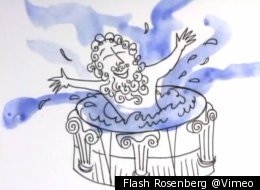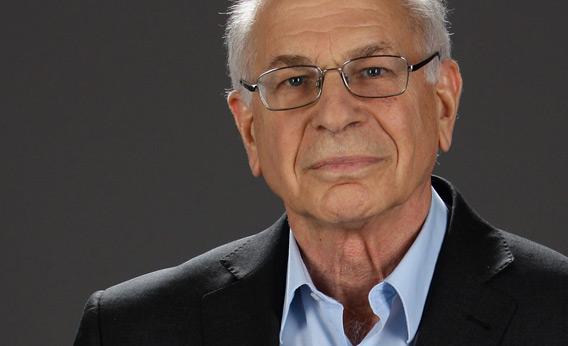In this MRI of a brain (side view), the green, yellow and red areas indicate bundles of neurons involved in addiction. Red represents reward pathways; green and yellow signify habitual responses.
In the past 10 or 15 years, there’s been a shift in thinking about addiction, to a new appreciation that it is, at its root, a maladaptive form of learning. And like learning to ride a bike, addiction is not quickly unlearned.
If you think quitting is a simple matter of willpower, you’re in good company. More than a third of the general public agrees, according to a 2008 survey by the federal Substance Abuse and Mental Health Services Administration. But it’s tougher than that.
“It’s kind of like putting on a lot of weight,” says Keith Humphreys, PhD, a Stanford professor of psychiatry and behavioral sciences who has served as a senior White House drug-policy advisor. “Your body changes, and from then on losing weight is way harder than it ever was before you got fat in the first place. Because addiction-associated brain changes are so enduring, a lot of people are going to relapse. So the course of treatment has got to be longer-term than it often is.”
Some of the key biological insights were made by Stanford neuroscientist Rob Malenka, MD, PhD, who continues his studies using animal models to extrapolate to humans. And now others, like brain imaging expert Sam McClure, PhD, are finding that changes Malenka sees in rats take place in humans as well.
This new understanding of addiction’s long-term grip has policy implications: A short-term detox stint to rid the body of the unwanted chemical just won’t cut it. Authorities have to be prepared to treat addiction as they would any chronic disease, even though that implies long-haul and therefore costlier treatment (it’s still a lot cheaper than imprisonment). An equally important implication: They must also try their best — from both health and cost standpoints — to prevent people from starting down that lonely, dangerous road in the first place.
Unforgettable
There are things you don’t forget, and there are things you can’t. For people who become drug addicts, the drug experience — the substance, but the entire “scene” too — is not only unforgettable but indelibly etched into the physiological brain circuitry that drives us onward through the obstacle course of existence.
And much of that memory is false. Because all addictive drugs appear to share a rather mysterious property: They’re “better than the real thing.” Better, that is, than the real things our reward circuitry was designed by evolution to reward: food, sleep, sex, friendship, novelty, etc. And better, even, than they were the last time around. At least, it sure seems that way to the addict.
About 25 million Americans are addicted to drugs (including alcohol but excluding nicotine), about the same number as those who have diabetes. But wanting a drug — really, seriously craving it — doesn’t mean you have to like it. “That’s a big part of the problem of addiction,” says Malenka, the Nancy Friend Pritzker Professor in the Department of Psychiatry and Behavioral Sciences. Malenka was among the first investigators to home in on the molecular details of just how the mechanisms involved in memory and learning are hijacked by drugs of abuse.
Addictive drugs mimic natural rewards such as food and sex by kindling a network of brain areas collectively called the reward circuitry, which is responsible for enjoyment — which if you think about it, is an important survival response. It gets us to do more of the kinds of things that keep us alive and lead to our having more offspring: food-seeking and ingestion, hunting and hoarding, selecting a mate and actually mating.
Moreover, addictive drugs fire up the reward circuitry in a way that natural rewards can’t — by, in a sense, pressing a heavy thumb down on the scale of pleasure. Over time, the desire for the drug becomes more important than the pleasure the addict gets from it. By the time the thrill is gone, long-lasting changes may have occurred within key regions of the brain.
The brain is a little bit like the big snarl of tangled wires snaking their way out of that six-outlet surge protector behind your bed. They know where they’re going, even if you don’t. Nerve cells (or neurons, as scientists call them) can be seen as hollow wires transmitting electrical currents down long cables called axons to other neurons.
Addiction was once defined in terms of physical symptoms of withdrawal, such as nausea and cramps in the case of heroin or
delirium tremens in the case of alcohol, which reflect physiological changes within cells of an addict’s body. It’s now seen as changes in brain circuits, or combinations of neurons; in other words, the very neurophysiological changes that result from learning and experience. You crave, seek and use a pernicious drug again and again because you have a memory of it being more wonderful than anything else, and because your brain has been rewired so that, when exposed to anything that reminds you of the drug, you will feel rotten if you don’t get some.
“These are symptoms of a brain disease, not a mere weakness of will,” Malenka says. He and other researchers are working to understand addiction as a sum of behavioral consequences of changes within nerve cells that occur with repeated drug use. Over time, these subcellular changes alter the strength of connections in the circuit, essentially hardwiring the yen for drugs into a habitual craving that is easily reignited not only by the drugs but also by environmental cues — people, places, things and situations associated with past drug use — even when the addict hasn’t been anywhere near the drug or the drug scene for months or years.
Serendipity strikes
In the 1950s James Olds, PhD, a postdoctoral researcher working with psychologist Peter Milner, PhD, at McGill University in Montreal, was conducting experiments to try to assemble a wiring diagram for some of this complicated brain circuitry. They were using a then-new technique, based on the understanding that neurons are at heart electrical critters, that came down to sticking electrodes (painlessly) into a rat’s brain, running an electric current and seeing what happened.
Your brain has been rewired so that, when exposed to anything that reminds you of the drug, you will feel rotten if you don’t get some.
At one point Olds and Milner were shooting for an area of the brain called the reticular formation, an archipelago of interconnected clusters dispersed throughout the brain and involved in arousal and attention. But they missed and hit another circuit by accident. They discovered that when they stimulated this circuit, the animals loved it.
So the investigators tried something new. They taught the rats to press a lever in order to deliver shocks to their own brains, and recorded the points in the brain that rats liked to electrically stimulate over and over again by pressing that lever — and press it they would, sometimes for hours on end, to the exclusion of just about anything including eating or drinking. (Of course, the rats couldn’t move the electrodes from one part of their brain to another. So Olds and Milner did that for them.)
Point by point, Olds and Milner were able to map the network of brain regions, interconnected as they are by bundles of axons running from one region to the next, that became known as the reward circuit. To oversimplify things a great deal, this circuit includes nerve bundles that run from deep inside the brain to spots such as the nucleus accumbens (associated with pleasure), the more recently evolved prefrontal cortex (involved in decision-making, planning and so forth), and other places of more ancient evolutionary vintage that control habitual movements and are sometimes referred to as the “lizard brain.”
A brain, viewed from behind in two planes, showing the pathways implicated in addiction. The pathway travels from dopamine neurons (central) to areas in the striatum.
But what flips on the reward circuit in regular life, when electrical zaps to the brain are blessedly few and far between? The same chemical that’s triggered by dope. It’s called dopamine.
Dope fires up your dopamine
Dopamine is one of a growing number of known neurotransmitters, substances neurons produce for the purpose of relaying information from one neuron to the next. Different groups of neurons manufacture different neurotransmitters, which all work pretty much the same way but in different nerve bundles and with a spectrum of different results. These substances are stored inside numerous tiny bulbs budding from points along a neuron’s long, electricity-conducting axon at key contact points the neuron shares with other neurons.
When an electrical signal roaring down the axon’s surface rumbles past one of these little bulbs, myriad molecules of neurotransmitters get squirted into the surrounding space. They diffuse across that space (called a synapse) to specialized receptors on the abutting neuron, where the interaction can either set off (enhance) or shut down (impede) a new electrical current in the downstream neuron.
These dopamine-squirting neurons constitute a tiny fraction of all neurons. But each of them can network with up to 10,000 or more other neurons stretching to the far corners of the brain. A dollop of dopamine in your tank can really boost your reward mileage, so to speak.
Once dopamine’s centrality to the neurons constituting the reward circuit was worked out, people started wondering whether drugs might activate the reward circuits. It turned out that they do.















